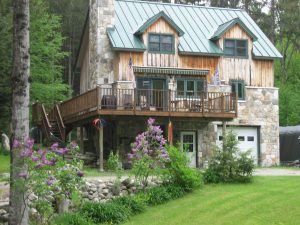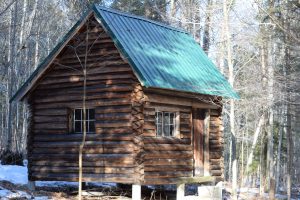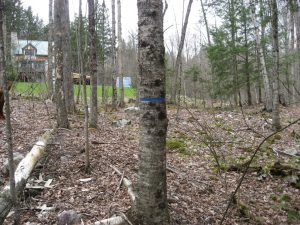by Alan Robertson
Introduction: This article started out as an attempt to provide information to affected Hemlock stand owners who were losing their trees to the Hemlock Woolly Adelgid (HWA). Unfortunately, or fortunately depending on your tree stand, the Emerald Ash Borer (EAB) was detected in Vermont, and, now, is firmly hunkered down in at least three geographical locations in the state. More unfortunately, that means that EAB will have more opportunities to quickly spread throughout the state. And the Hemlock, realistically, isn’t going away anytime soon in Vermont because HWA is susceptible to cold temperatures and has experienced some severe winter mortality annually in the southern part of the state, so not a “doomsday” situation yet …
With this in mind, we’ve reoriented the article to ash trees to help Vermont forest landowners with some decisions they didn’t even know they’d have or could be involved in.
First, is this the end of the ash tree species as we know it? The short answer is yes; over the next few years the EAB will continue to spread and probably won’t stop until it reaches the northern limits of civilization in Canada. EAB has already found its way south past North Carolina where the damage is compounded due to the recent loss of all their Hemlock. But the bottom line is that most ash in the US, like the American elm, and in the far past, the American chestnut, will die. But is there hope for the future that this tree could again be found throughout the United States? Yes, someday, and that is what this article is all about.
The US has seen several tree species severely compromised over the past century; the list includes, here in the east, the butternut, the American chestnut, the American elm, American beech, and some species native to the deep south. All are being lost due to invasive insects and diseases. The nature of the attacks on these trees is a critical element in their loss. All trees have the ability to adapt to changing conditions through naturally occurring genetic changes (mutations) or genetic variations occurring naturally within the species. And when change comes slowly, like over thousands of years, most trees eventually adapt. But when that change comes quickly, like when a Chinese pallet infested with beetles, or a batch of foreign-grown flowers infested with insects or fungus lands at a dock in the US, the quick introduction of the pest cannot be tolerated by the local plants, and they succumb.
But how can we address this too-rapid change model? By instituting our own methods of helping endangered tree species quickly change and adapt to the invasive threat, or using similar methods to make the life of the invasive insect or fungus as miserable as possible. And just as important, how much effort do we need to spend in the salvation of these tree species, and is it worth the effort to do this?
The answer to this last question is critical to justifying both the immediate effort and the vast time frame and resources we are looking at to restore a tree species which, first, will basically disappear. Just how valuable are the ash, elm, chestnut, and beech? Let us count the ways:
- Ecologically, all tree species have a niche in the forest. While biologists know a lot about trees, the incredible detail and minutia associated with each tree are still not entirely known or understood; we don’t know what we don’t know, and that makes the loss very scary.
- Economically, these trees (well, most of them) were incredibly valuable, could be made into a broad variety of valuable products, and were worth a lot of money; so, considerable economic loss …
- Aesthetically, these trees represent some of the most beautiful trees on the planet. All of them can get REALLY large, tall, and broad. So great were these trees that most, especially the Elm, were planted on virtually every street in the country east of the Mississippi. And finding comparable replacements is getting a lot harder …
- Culturally, these trees had found their way into the very soul of American society, and references may be found in stories, novels, poems, and histories.
So, the case has hopefully been made for expending the effort it will take to return these trees to our landscape. And it should be noted that the science behind all of the ways to bring these trees back is rapidly becoming less expensive as we learn more about tree genetics. We’re talking about a few million dollars, not billions …
So, how do we bring these trees back? There are several strategies for doing this, but first, how do we bring them back if they are all gone?
Again, this is the crux of this article.
Generally, when looking at making the tree species less susceptible to the threat we are talking about an enhancement of genetic resistance, so that a more impervious tree will pass that resistance to future generations. Improved or enhanced genetic resistance may be done through selectively breeding for resistance, hybrid breeding, or resistance introduced through biotechnological means.
Quickly summarizing the science, selective breeding means finding some individual tree or trees which seem to have a better resistance to the threat than the rest. Efforts are then made through additional tree breeding generations to emphasize that trait. With American beech we have found a number of American beech that are resistant to the beech scale, the insect that initiates the beech bark disease, and was brought to the western hemisphere on infected European beech many decades ago. So, eventually (hundreds of years) the American beech may breed itself back to health. Elms with enhanced resistance are also beginning to be available. Hybrid breeding means crossing the tree under threat with a close relative that is resistant to the disease or bug. The hybridization is accomplished over a few generations of crossing to bring out the resistance trait in the hybrid, and eventually end up with a resistant tree of the original species. The American Chestnut Foundation (TACF) is doing this right now with a back-cross breeding program involving the American chestnut and the Chinese chestnut with considerable success. Resistance introduced through biotechnological means includes a variety of new genetic technologies, including “CRISPR”, which has been highlighted in articles in Time, National Geographic, and Smithsonian magazine. Biotechnological means include transgenic methods (gene or genetic material that has been transferred by any of a number of genetic engineering techniques from one organism to another that could not otherwise be conventionally bred. The introduction of a transgene [called “transgenesis”] has the potential to change the phenotype of an organism.) and cisgenic methods (gene or genetic material that has been transferred by any of a number of genetic engineering techniques between organisms that could otherwise be conventionally bred. Unlike in transgenesis, genes are only transferred between closely related organisms.). TACF is also using transgenic methods in bringing back the chestnut- a wheat gene has been introduced into the American chestnut to counteract the acids the chestnut blight fungus produces when it attacks the chestnut.
Getting back the question of how to salvage the trees if they are all gone is where we come into the picture. There is a need to keep a reservoir of native tree germplasm far into the future for use in propagating resistant trees. Like people, every tree has a slightly different gene makeup, and trees of the same species in different regions have slightly different genetic makeups too. So trying to grow a southern chestnut in New York probably won’t work as well as working with New York chestnuts in New York. Vermont ash trees are slightly different than those in Michigan. If we are ever to bring ash back we should be working with trees from, and adapted to Vermont.
And, finally, the more genetic variation in the population of trees we try to bring back the better the chances that those variations will help trees of that species survive; we don’t need in-bred trees for doing this work.
The answer to our question then, is we need to maintain a healthy number of ash trees scattered around Vermont (actually throughout its entire range) during the loss of the rest from the EAB. We do this through treating a few trees with chemicals that will give them protection from the Emerald Ash Borer. The second half of this article will explain the process for saving a few trees.
Saving Some Trees
In the first half of this article, we explained why saving a few trees is critical to any future effort to resurrect the species, specifically ash. But there are a lot of factors and decisions in this process to insure the right tree is treated the right way with the right chemicals at the right time by the right people.
Before we get into the decision process we need to be clear on some related issues. First, we are not advocating some major effort to save even a small percentage of the ash in Vermont. The cost would be ridiculously high, the effort would not be practical, and the amount of chemicals would be catastrophic to the environment. This is a very small strategic effort using a lot of science. Second, none of this would have been necessary had our country invested in stringent importation controls and given APHIS the tools needed to stop the problems from entering the country. You need to know that politics have been a major influence on the phytosanitary standards enacted by the government and APHIS has been hamstrung at several levels in their attempts to control the import of wood products and plant material. It is still a problem despite the clear destruction invasives have wrought in the US. Finally, we are talking about using chemicals and we have mentioned that some of the salvation techniques involve GMO’s. These are controversial things to say in Vermont. The efforts we are discussing do try to minimize both the use and methods of chemical application, and the GMO’s TACF has developed for the American chestnut still have to undergo some incredibly stringent federal review by at least three agencies ( USDA, EPA, and the FDA), taking years before they might be allowed out in the real world. The ash, if those techniques are used, would face the same or probably more scrutiny. Keep in mind that the trees under threat face certain extinction, and that it’s too late to expect nature to step in and save the species …
Here is what you need to know if you think you might have some candidate trees:
- We are talking about ash trees commonly found in Vermont: White ash, Green ash, and Black (or Brown) ash. You need to know what the trees look like and which is which. You also need to know that there are male and female trees for all three and Black ash also exhibit both male and female traits on the same tree. Seek some reference works or advice from a forester if you’re not sure what you have. In the deep forest you will need binoculars and good timing to tell the sex of the trees.
- The tree should be very healthy. Damaged trees (lightning damage, significant broken- off branches, wounds, missing bark, woodpecker damage, water sprouts at the base of the tree, thin volume of leaves or branches without many leaves) should not be chosen. The EAB is actually attracted to damaged trees because the insect uses chemical signals given off by the tree as well as visual (silhouette) and color cues to find the tree.
- The tree should be structurally balanced, sound, and for trees in the woods, impressively straight and clear. Size diameters (DBH) should range 2” and up.
If the tree meets all of these standards it should also meet these criteria:
- It should be located on a good site – reasonably flat, good soils, not wet or swampy
- The tree, if not in the forest, should have value because of its landscape or aesthetic value
- The tree property should be at least 5 (preferably ten) miles away from the nearest EAB outbreak. While the insect only moves 2 miles a year the outbreaks in and around Vermont bring home our ignorance of exactly where the insect may be. Treating an infested tree can be a waste of money and effort; past a certain level of infection the tree may not recover if treated. Given the investment in time and energy to preserve the tree consider only very healthy trees- it is better to start treatment before the bug is detected than to wait until the bug is too close. See photos for levels of infestation
If you still have candidate trees after meeting the above standards, please consider how many trees you might be willing to spend money on. The aspects of this include how many and what size trees you have, the cost per tree, how many trees you might be considering for treatment, and how long would you expect to have to do this.
The first task is to complete an inventory of what ash you have. You would not need to capture every tree but for the decision process you do need to know the location, size, type of ash, and condition.
Cost is another issue. While it is possible to treat your own trees, primarily the very small ones, don’t do it yourself! We highly recommend you seek a professional – an arborist – to treat large specimens or if you have a number of trees you are thinking of treating. The cost numbers we have here are from a North Carolina institution that hired an expert to treat 15 trees (trunk injection- the most expensive and reliable method) for a biennial (every two years!) cost of $1600. The sum of the DBH of the trees was 225 inches making the cost roughly $3.50 per inch of tree per year. Doing lesser numbers of trees will cost significantly more per tree especially if an arborist has to travel a distance, and if the tree is at a remote site. VWA is currently canvassing arborists in Vermont to see who will offer ash treatment services.
What are the treatment options?
There is only one method in Vermont that is better than the rest and is recommended because it limits the chemicals used, doesn’t involve neonicotinoids (possibly harming honey bees) and acts more directly on the tree and, eventually, the insect:
Trunk Injections: Probably the most reliable method and the only method to be used on larger trees (over 8” DBH). First, the tree is literally tapped just like a sugar maple, but much lower, no higher than18” from the ground; the drill bit being about 3/8”, the depth extending 5/8” to 2” into the sapwood. The number of injection sites (tap holes) depends on the tree diameter and averages every 4-8” of tree circumference. The equipment includes injection port plugs (see photo) which are left in the tree, the injection equipment and tubing, and the reservoir of diluted chemical. Dosage (amount of diluted insecticide) and the number of ports depend on the tree size and the insect – EAB warrants higher dosages than many insects. The treatment lasts two years. Care should be taken to use sterile equipment to limit any tree infections from the treatment. Chemicals used include Emamectin benzoate (TREE-age), and Azadirachtin (Azasol and TreeAzin). The work should be done in mid to late spring after the trees have leafed out in weather conditions similar to the other treatment methods to insure maximum tree uptake. Because of the technical difficulty, the cost of the equipment, the strength of the insecticides, and the need for experience in doing the work, only experts should attempt the work, specifically a trained arborist. The VWA will have a listing on its website listing ISA certified arborists in Vermont providing these treatment options.
(NOTE: Experts do recognize soil drenches and injections around the tree trunk as an effective protective procedure, primarily around smaller trees, but the chemicals these treatments use are exclusively neonicotinoids which are linked to honey bee colony collapse disorder (CCD) and are not recommended in the state of Vermont; in any case only an International Society of Arboriculture (ISA) certified expert arborist should be using these methods)
Lastly, how many years will the treatments be necessary? No one knows, but at a minimum of 15 years. Like the Elm, once all the other trees are dead the insect will largely disappear and lighter treatments may be possible. By that time there should be further research into developing a resistant tree or finding biotechnological ways to control or eliminate the insect. In any case without some saved healthy ash trees restoring the species will be much more difficult.









